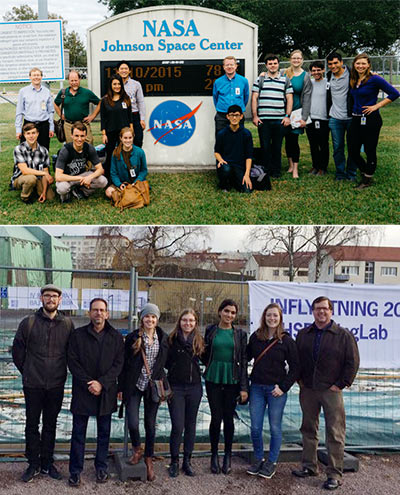Swedish ‘living lab’ links Rice students with international universities, industry partners, experts
Don Ostdiek, associate dean of undergraduates, has a vision and is on a mission: Reimagine international study-abroad experiences for Rice students.
Spurred by President David Leebron’s call to expand the international experience, Ostdiek began brainstorming opportunities to engage students whose majors do not easily lend themselves to being removed from coursework or labs for extended periods of time.

In early November Rice students participated simultaneously in sustainable-design workshops both locally at NASA’s Johnson Space Center (top) and on the Chalmers campus in Sweden (bottom.)
“Not every student has the time or money to spend an entire semester or year in a foreign country, so we’re offering an option that provides that international experience in a different way,” Ostdiek said.
The alternative is a course or project that is based on campus — or at local industry partners, like NASA — but includes a curriculum component that will send students abroad to implement their developments.
A recent collaboration with Chalmers University of Technology in Sweden helped accomplish this goal for two groups of Rice students. In early November the students participated simultaneously in sustainable-design workshops both locally at NASA’s Johnson Space Center and on the Chalmers campus, which is building a “living lab.” The Swedish lab will house 25 residential apartments in a three-story structure and will serve as a research arena for sustainable housing of the future.
The majority of the students traveled with Richard Johnson ’92, director of Rice’s Administrative Center for Sustainability and Energy Management, to NASA, where they assisted with the development of kitchen modules.
“The intent has been to develop new concepts for sustainable living and social well-being not just for a future resource-constrained life on Earth, but also for applications in outer-space environments,” Johnson said. “Some of these ideas might find their way into the thinking for a space module for the 2030 Mars mission.”
Will Rice College junior Kate Thomas was one of four students who traveled to the Chalmers campus in Sweden. Thomas worked with a Swedish graduate student and a living-lab expert at Chalmers.
“Our group focused on ideas for how an integrated farming program would work in the living lab,” Thomas said.
Her group collaborated not only with other teams at Chalmers, but also with Johnson’s team back at in Houston via online messaging.
“I know we all gained a lot of understanding from going to Chalmers and seeing the site for the living lab, the model and the structure of the co-creation program,” Thomas said. “I hope to use these understandings to help create other international experiences for Rice students similar to this — for example, a class centered around a co-creation workshop.”
And that is precisely the bigger goal, Ostdiek said.
“These students are helping co-create the program as they go,” he said. “Not only are they part of a co-collaboration project to design and implement sustainable components of the living lab, but they are also partnering with us to create a new and exciting program.”


Leave a Reply